
The Tippecanoe River is a gentle, 182-mile-long (293 km) river in the Central Corn Belt Plains ecoregion in northern Indiana. It flows from Crooked Lake in Noble County to the Wabash River near what is now Battle Ground, about 12 miles (19 km) northeast of Lafayette. The name "Tippecanoe" was derived from a Miami-Illinois word for buffalo fish, reconstructed as */kiteepihkwana/ or as kiteepihkwana siipiiwi.

The zebra mussel is a small freshwater mussel. The species was originally native to the lakes of southern Russia and Ukraine, but has been accidentally introduced to numerous other areas and has become an invasive species in many countries worldwide. Since the 1980s, the species has invaded the Great Lakes, Hudson River, and Lake Travis.
The Sydenham River is a river in Chatham-Kent, Lambton County and Middlesex County in southwestern Ontario, Canada, flowing southwest from its source west of London, Ontario and emptying into Lake Saint Clair. The length of the river is 165 kilometres (103 mi) and it drains a watershed of approximately 2,700 square kilometres (1,000 sq mi). The river flows through the towns of Strathroy and Wallaceburg. It was named after Lord Sydenham, governor of Canada from 1839 to 1841.

The dwarf wedgemussel is an endangered species of freshwater mussel, an aquatic bivalve mollusk in the family Unionidae, the river mussels.

The Sydney River is a short river located in Cape Breton County, Nova Scotia, Canada. Historically, it was also referred to as the Spanish River from the 18th century French name for its estuary, Baie d’Espagnols. It separates the communities of Coxheath and Westmount, on the north bank of the river, from Howie Centre, Sydney River, and Sydney on the south and east banks.

The northern riffleshell, is a subspecies of freshwater mussel, an aquatic bivalve mollusk in the family Unionidae, the river mussels.

The freshwater pearl mussel is an endangered species of freshwater mussel, an aquatic bivalve mollusc in the family Margaritiferidae.
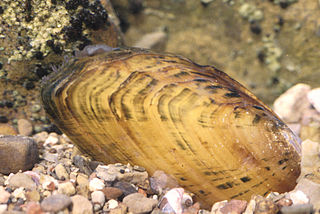
The cracking pearlymussel is an endangered species of freshwater mussel, an aquatic bivalve mollusk in the family Unionidae.
Hay Swamp is a provincially significant wetland complex, 1839 hectares in size, located in parts of the central land areas of the municipalities of Bluewater and South Huron, in southwestern Ontario, Canada. Approximately 13 kilometers (8.1 mi) in length and 2 kilometers (1.2 mi) in width, at its widest point; it consists of 15 extensively forested individual wetlands, situated on either side, of sections of both the upper drainage of the Ausable River and its tributary, Black Creek.
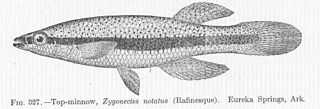
The blackstripe topminnow, Fundulus notatus, is a small freshwater fish in the family Fundulidae, found in central North America.

Lampsilis abrupta, the pink mucket or pink mucket pearly mussel, is a species of freshwater mussel, an aquatic bivalve mollusk in the family Unionidae, the river mussels. This species is endemic to the United States.

Lampsilis is a genus of freshwater mussels, aquatic bivalve mollusks in the family Unionidae, the river mussels. There are over 100 species in the genus.

Lampsilis cariosa, the yellow lampmussel, is a species of freshwater mussel, an aquatic bivalve mollusk in the family Unionidae, the river mussels.

Lampsilis higginsii is a rare species of freshwater mussel known as Higgins' eye pearly mussel or simply Higgins' eye. It is endemic to the United States, where it occurs in the upper Mississippi River and the drainages of some of its tributaries. It is threatened by the introduced zebra mussel. Lapsilis higginsii is a federally listed endangered species.
Lampsilis rafinesqueana, the Neosho mucket or Neosho pearly mussel, is a species of North American freshwater mussel endemic to Arkansas, Oklahoma, Illinois, Missouri and Kansas.
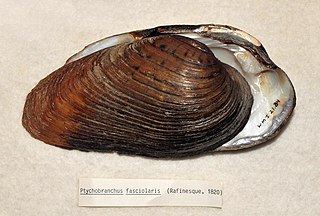
Ptychobranchus fasciolaris is a species of freshwater mussel in the family Unionidae, the river mussels. Its common name is kidneyshell.

Simpsonaias ambigua, the salamander mussel or mudpuppy mussel, is a species of bivalve in the family Unionidae. It is unique among freshwater mussels in using mudpuppies as its glochidial host. It is the only freshwater mussel known to have a non-fish host.
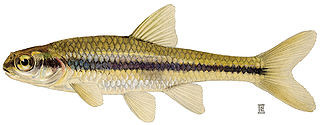
The bridle shiner is a member of the minnow family (Cyprinidae). This species has been identified as being of Special Concern by the Committee on the Status of Endangered Wildlife in Canada (COSEWIC).
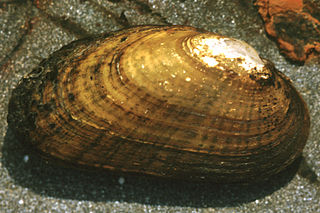
Villosa iris, the rainbow mussel or rainbow-shell, is a species of freshwater mussel, an aquatic bivalve mollusk in the family Unionidae, the river mussels.

Canadian aquatic invasive species are all forms of life that traditionally has not been native to Canada's waterways. In Eastern Canada, non-native plant and animal species are a concern to biologists. Bringing non-native species such as invasive fishes into Canada can damage the environment and ecosystem by repressing native species due to food competition or preying. Invasive fishes enter the fresh waters of Canada in several ways including drifting, deliberate introduction, accidental release, experimental purposes and, most commonly, through the attachment on international boat hulls. Invasive species are the second biggest threat to fish and other marine life in Canada behind loss of habitat and degradation. The threat to native species is primarily caused by impacts on the food web; however, invasive species also bring dangerous pathogens and physically interfere with existing aquatic life. Invasive species include sea lampreys, zebra mussels, smallmouth bass, European green crab, vase tunicate, and sea squirts.


















